The Elk Hair caddis and its variations are my favourite dry flies for trout and grayling fishing because they are relatively easy to tie, robust, and versatile patterns.
Al Troth designed the original fly (top left image) in the 1950s for fishing the rivers in Pennsylvania, but it will catch trout and grayling on any river containing a healthy population of caddis.
Its design is key to its success because it incorporates all the elements to achieve a high floating dry fly. The light wing makes it easy to see, and the palmered hackle and Elk’s hair cause it to float high.
Also, when skated across a river during the summer months, it effectively mimics a scurrying adult caddis that trout find irresistible.
So, let’s move on to tying this great caddis fly pattern, followed by three variations of this classic that I’ve fished for more years than I care to count…
How to tie the Elk Hair Caddis flies I regularly fish:
First up is my take on Troth’s original caddis dry fly pattern that I fish during the summer months on northwest UK rivers…
Fly tying material list:
- Hook: Kamansan B170 (#16, 14 & 12)
- Thread: 8/0 Burnt orange
- Body: Fox Squirrel dubbing (WAPSI)
- Rib: Silver wire
- Hackle: Brown genetic cock
- Wing: Bleached Elk Hair

Step 1. Catch the waxed tying thread onto the hook 1 mm behind the eye. Catch in the silver wire rib while winding the waxed thread, in touching turns, towards the hook bend.
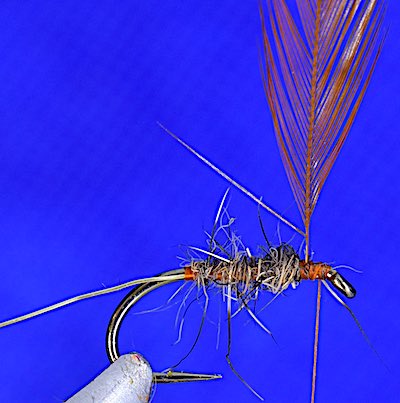
Step 2. Dub the waxed thread with Hare’s ear fur and wind it forward towards the eye to form the fly’s body. Prepare the brown cock feather by stripping the fibres from its base and tying it onto the hook near the eye.

Step 3. Secure the tip of the cock feather in a pair of hackle pliers and form a palmered hackle by winding the feather down the hook to its bend. Using the silver wire, catch the end of the feather and wind the wire in open turns up the hook shank. Secure the end of the wire with the thread, and trim the waist.
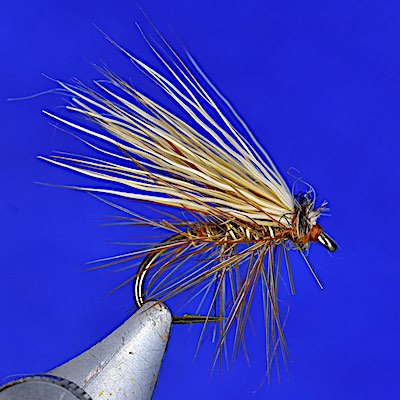
Step 4. Cut a bunch of bleached elk hair fibres, remove the underfur, and align the hair tips using a stacker. Remove the hair from the stacker and cut it to length so that the wing extends just past the hook bend. Secure the elk wing onto the hook by making two loose turns of tying thread around the hair and pulling tight. Apply a pinch of Hare’s Ear dubbing to the waxed thread and make a couple more turns of tying thread. Finally, apply a drop of varnish to the thread and whip finish.
When and how to fish the Elk Hair Caddis?
On many rivers during the summer months, juicy caddisflies are eagerly taken by trout and grayling. Either as they hatch, blown onto the water from bankside bushes and vegetation, or when the mature caddis flies return to the river to lay their eggs.
This caddis fly works well during the day whenever there is a caddis fly hatch or the possibility of one. However, my approach to fishing the Elk hair caddis dry fly depends on the weather and river conditions.
On bright sunny days when the river is crystal clear, I find it best to fish at daybreak and as the light fades in the evening.
Don’t be fooled by the absence of rising fish because trout and grayling are likely to be lying in wait for a tasty meal to float overhead. In this scenario, adopt a prospecting approach and dead drift the caddis dry fly over likely lies:
- heads & tails of pools
- boulders and snags
- under bankside vegetation
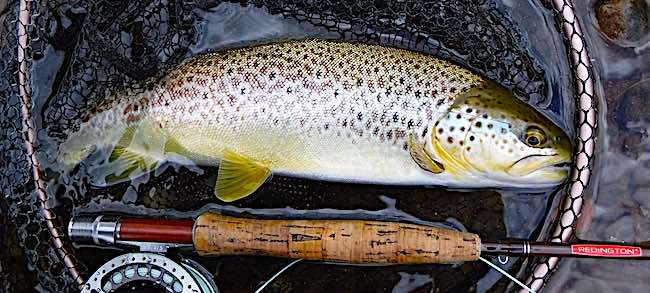
If you see bats flying above the river on mild evenings, they are likely to be feeding on caddisflies as they hatch. In this situation casting the caddis fly across the river and letting it skate around to the dangle. This approach often produces volitant takes from trout, grayling, and sea trout if they are present.
Equipment-wise, I use a 9ft 5# rod for dry fly fishing. Attached to the floating line is a 9ft 5X copolymer leader tipped with a 3 to 4 ft length of 3lb fluorocarbon. Fuller’s mud is applied to the fluorocarbon tippet to remove its shine and make it sink. Whereas, Mucilin grease is applied to the remainder of the leader so that it floats.
Early season Elk Hair Caddis variants
Al Troth’s caddis is an excellent pattern for summer trout and grayling. However, the simple modifications of removing the palmered hackle, using unbleached elk hair, and adding a tag (cream or orange) turn it into a…
great Elk Hair dry fly for imitating early-season olives:
(e.g. Large Dark Olives, March Brown, and Large Brook Dun)
So, let’s take a look at how I tie these caddis dry fly variants…
Cream tagged Elk Hair caddis material list:
- Hook: Kamansan B170 (#14 & 12)
- Thread: 8/0 Burnt orange
- Tag: Cream Antron Yarn
- Body: Fox Squirrel dubbing (WAPSI)
- Rib: Gold wire
- Wing: Natural elk hair

Step 1. Catch the waxed tying thread onto the hook 1 mm behind the eye. Catch in the silver wire rib and cream Antron yarn while winding the waxed thread, in touching turns, to 2mm past the hook point.
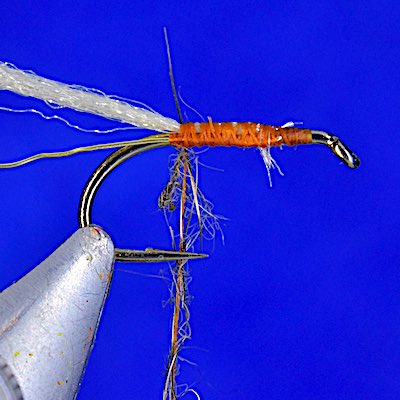
Step 2. Wax the tying thread and lightly dub it with the Hare’s ear fur.
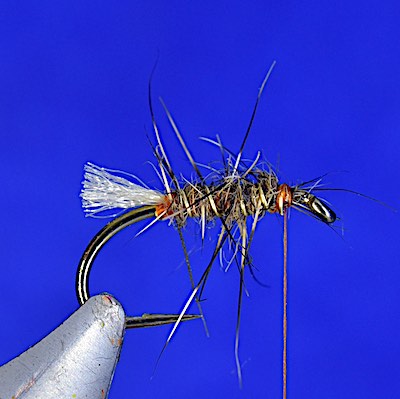
Step 3. Form the fly’s body by winding the dubbed thread towards the eye. To secure the dubbing, wind the gold wire around the body (4 open turns). Neatly tie off the wire using the thread and trim any waste. Next, cut the Antron yarm to form the tag.

Step 4. Cut a bunch of elk hair fibres, remove the underfur, and align the tips using a stacker. Remove the hair from the stacker and cut it to length so that the wing extends just past the hook bend. Secure the hair onto the hook by making two loose turns of tying thread around the elk wing and pulling tight.
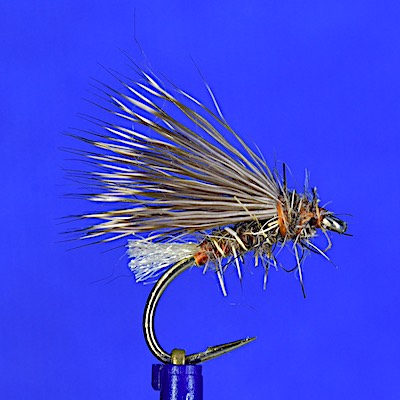
Step 5. Apply a pinch of Hare’s Ear dubbing to the waxed thread and make a couple more turns of tying thread. Finally, apply a drop of varnish to the thread and whip finish.
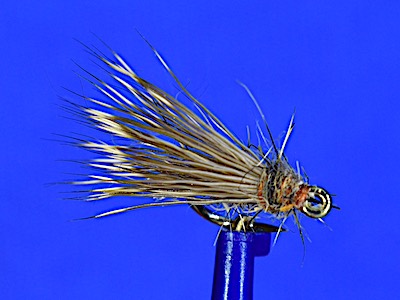
Top view of the finished caddis fly
When to fish the early season EH caddis dry flies?
In spring, large dark olives can spend a minute, or two, drying their wing while sailing downriver before fluttering away. If trout are picking off these olives, fishing the cream-tagged Elk hair caddis usually fools overwintered brownies.
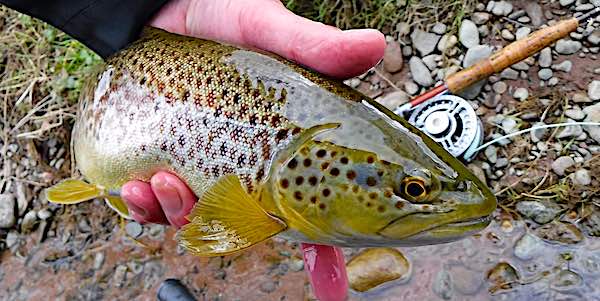
When there isn’t a hatch of olives, try fishing the orange-tagged variant because it will often tempt a few trout to the surface.
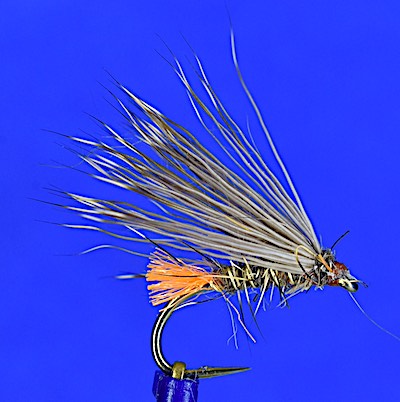
Orange tag Elk Hair Caddis
- Hook: Kamansan B170 (#14 & 12)
- Thread: 8/0 Burnt orange
- Tag: Fluoroescent Orange Antron Yarn
- Body: Fox Squirrel dubbing (WAPSI)
- Rib: Gold wire
- Wing: Natural elk hair
On the Welsh Dee, the Grammon fly appears in April and is the first caddis fly of the year. I found that fishing the following medium olive Elk hair caddis fly, fools trout feeding on Gammon flies. Thus, they are a worthy addition to your dry fly box.
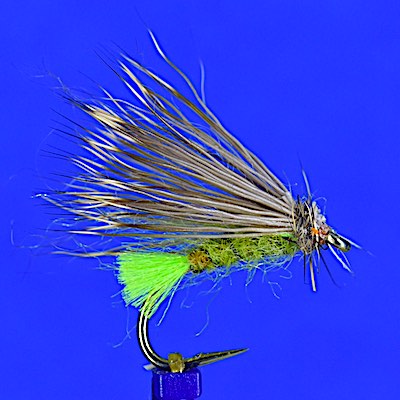
Medium-olive EH caddis
- Hook: Kamansan B170 (#14)
- Thread: 8/0 Burnt orange
- Tag: Fluoroescent Green Floss
- Body: SLF medium-olive dubbing
- Rib: Black wire wire
- Wing: Natural elk hair
Finally, I hope you’ve enjoyed this article on how to tie Elk Hair caddis fly patterns, and these dry flies help you catch plenty of trout and grayling.

Thanks for another great post. I’ve found the E.H.C. a great fly for Grayling on The Ribble, Hodder and the Dales Rivers at all times of year.
Hi David,
Great to hear you enjoyed the post and thanks for your comments on using EHC on the other rivers.
Cheers, Andrew
Hi,Andrew
yet again very informative hopefully I will use them late spring ,early summer
cheers
Good luck